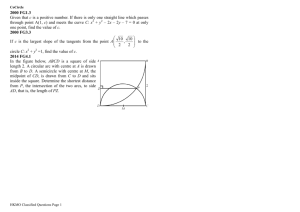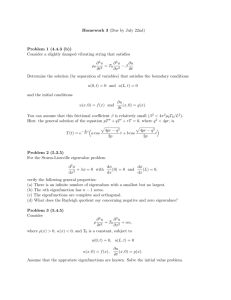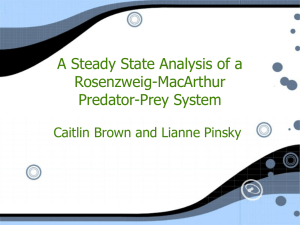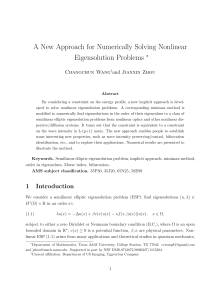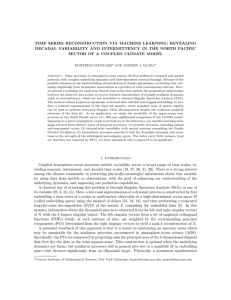ETMS AND SO ON
advertisement
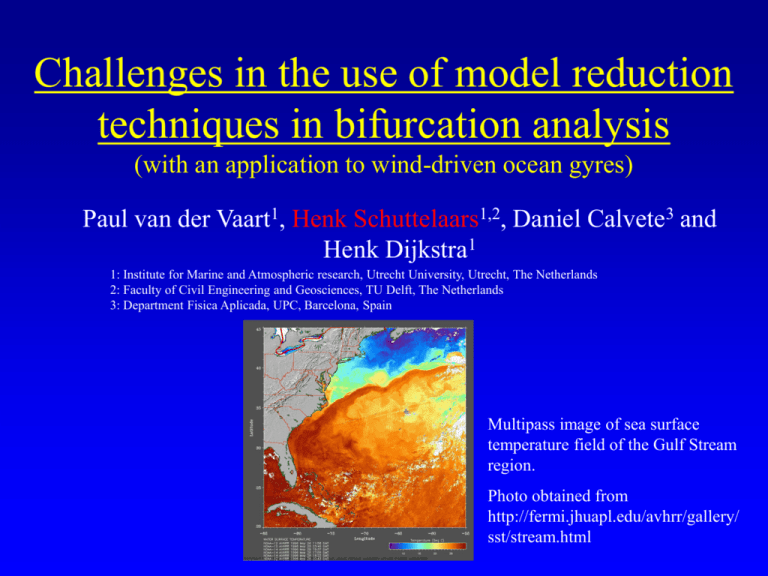
Challenges in the use of model reduction techniques in bifurcation analysis (with an application to wind-driven ocean gyres) Paul van der Vaart1, Henk Schuttelaars1,2, Daniel Calvete3 and Henk Dijkstra1 1: Institute for Marine and Atmospheric research, Utrecht University, Utrecht, The Netherlands 2: Faculty of Civil Engineering and Geosciences, TU Delft, The Netherlands 3: Department Fisica Aplicada, UPC, Barcelona, Spain Multipass image of sea surface temperature field of the Gulf Stream region. Photo obtained from http://fermi.jhuapl.edu/avhrr/gallery/ sst/stream.html Introduction • From observations in: • meteorology • ocean dynamics • morphodynamics •… Warm eddy, moving to the West Dynamics seems to be governed by only a few patterns Often strongly nonlinear!! Wadden Sea Research Questions: Can we model understand predict the observed dynamical behaviour? Model Approach: reduced dynamical models, deterministic! • Based on a few physically relevant patterns physically interpretable patterns • Can be analysed with well-known mathematical techniques Choice of patterns!! Construction of reduced models Define: state vector F = (…), i.e. velocity fields, bed level,… parameter vector l = (…), i.e. friction strength, basin geometry Dynamics of F: •coupled system of nonlinear ordinary and partial differential equations •usually NOT SELF-ADJOINT dF M dt + L(l) F + N(l,F) = F Where •M : mass matrix, a linear operator. In many problems M is singular •L : linear operator •N : nonlinear operator • F : forcing vector Step 1: identify a steady state solution Feq for a certain l. L(l) Feq + N(l,Feq) = F Step 2: investigate the linear stability of Feq. Write F = Feq + f and linearize the eqn’s: df M dt + J(l) f = 0 with the total jacobian J = L (l) + N (l,f,Feq) with N linearized around Feq This generalized eigenvalue-problem (usually solved numerically) gives: •Eigenvectors rk •Adjoint eigenvectors lk These sets of eigenfunctions satisfy: •< J rk, lk > = sk •< M rk , lm > = dkm with <.>: inner product sk : eigenvalue Note: if M is singular, the eigenfunctions do not span the complete function space! Step 3: model reduction by Galerkin projection on eigenfunctions. •Expand f in a FINITE number of eigenfunctions: N f = S rj aj(t) j=1 •Insert F = Feq + f in the equations. •Project on the adjoint eigenfunctions for the amplitudes aj(t): N N evolution equations N aj,t - k=1 Sbjk ak + S S c a a = 0, k=1 l=1 jkl k l system of nonlinear PDE’s reduced to a system of coupled ODE’s. for j = 1...N Open questions w.r.t. the method of model reduction: •Which eigenfunctions should be used? •How many eigenfunctions should be used in the expansion? •How ‘good’ is the reduced model? To focus on these research questions, the problem must satisfy the following conditions: • not self-adjoint • validation of reduced model results with full model results must be possible • no nonlinear algebraic equations Example: ocean gyres Gulf stream: resulting from two gyres Not steady: •Temporal variability on many timescales •Results in low frequency signals in the climate system Subpolar Gyre Subtropical Gyre “Western Intensification” Temporal behaviour of gulf stream from observations from state-of-the-art models Two distinct energy states (low frequency signal) Oscillation with 9-month timescale (After Schmeits, 2001) One layer QG model • Geometry: square basin of 1000 by 1000 km. • Forcing: symmetric, time-independent wind stress Step ‘0’ • Equations: + appropriate b.c. • Critical parameter is the Reynolds number R: •High friction (low R): stationary Route to chaos •Low friction (high R): chaotic Step 1 Bifurcation diagram resulting from full model (with 104 degrees of freedom): •R<82: steady state •R=82: Hopf bifurcation •R=105: Naimark-Sacker bifurcation Steady state: pattern of stream function near R = 82 (steady sol’n) Step 2 At R=82 this steady state becomes unstable. A linear stability analysis results in the following spectrum: QUESTION: which modes to select? •Most unstable ones •Most unstable ones + steady modes •Use full model results and projections Step 3 Example: take the first 20 eigenfunctions to construct reduced model. Time series from amplitudes of eigenfunctions in reduced model Black: Rossby basin mode (1st Hopf) Red + Orange: Gyre modes (Naimark-Sacker) Blue: Mode number 19 •Quasi-periodic behaviour at R =120: Neimark-Sacker bifurcation •Good correspondence with full model results Another selection of eigenfunctions to construct reduced model. •Mode 19 essential •Choice only possible with information of full model Rectification in full model Mode #19 Conlusions w.r.t. reduced models of one layer QG-model: •More modes do not necessarily improve the results: •Modes can be compensated by clusters of modes deep in the spectrum (both physical and numerical modes) •By non-selfadjointness, these modes do get finite amplitudes •Mode # 19 is essential: this mode is necessary to stabilize. physical mechanism! Low frequency behaviour: Two layer QG model Instead of one layer, a second, active layer is introduced allows for an extra instability by vertical shear (baroclinic) •Bifurcation diagram from full model: again a Hopf and N-S bifurcation. •In reduced model (after arbitrary # of modes), a N-S bif. is observed: •Different R •Different frequency N-S Reduced model •Linear spectrum looks like the spectrum from 1 layer QG model. •Use basis of eigenfunctions calculated at R=17.9 (1st Hopf bif) and increase the number of e.f. for projection: •Some modes are active (clusters). •Which modes depends on R •Note weakly nonlinear behaviour!! E= || ffull – fproj|| •E = || ffull|| Conclusions: •Possible to construct ‘correct’ reduced model •Insight in underlying physics •Full model results selection of eigenfunctions Challenge: To construct a reduced model without a priori knowledge of the underlying system’s behaviour in a systematic way Apart from the problems mentioned above (mode selection, ..), this method should work for coupled systems of nonlinear ‘algebraic’ equations and PDE’s as well.


